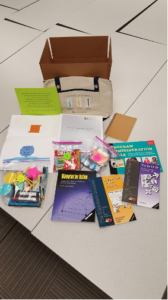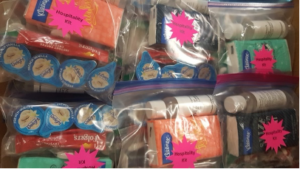BY Marleen Barrett, M.S. | March 8, 2022
This document may be printed, photocopied, and disseminated freely with attribution. All content is the property of the McCormick Center for Early Childhood Leadership.
Pamper: To treat with extreme or excessive care and attention.1
Do you enjoy being pampered? Maybe it is treating yourself to a service you do not often indulge in, for example, a manicure or pedicure, a massage, a fine dining experience, or a car detailing.
Pampering participants is a foundational principle at the McCormick Center for Early Childhood Leadership. Paula Jorde Bloom, the McCormick Center Founder, was passionate about ensuring that anyone who participated in our trainings left feeling cared for and pampered. Thirty-seven years later, we continue to carry on this principle for participants. Over time, our team came to refer to this as the “McCormick Center Experience.”
The “McCormick Center Experience” is about showing appreciation and respect through attention to all the details that make up a high-quality training experience. Hospitality, best practices in adult learning, activities that engage the five senses, reflection, and laughter are all a part of this experience.
Prior to the pandemic, trainings offered at the McCormick Center were in-person. Upon arrival, participants experienced warm greetings, fresh flowers on the training and dining tables, and soothing music. The training tables were stocked with supplies such as markers, highlighters, and post-it notes. In addition, a bag of training materials, books, and other resources were neatly placed on each participant’s seat. A hospitality table was set up in the training room with items to meet physical needs, such as water to keep you hydrated, blankets, and handheld fans for those who needed to warm up or cool down. Hand lotion, hand sanitizer, tissues, mints, and snacks were also provided. Coffee and hot water for tea were ready when participants arrived. Participants enjoyed healthy and hot buffet lunches together in the dining room with extra time to get to know one another. Encouraging and inspirational messages were on the walls throughout the McCormick Center. Activities during the training allowed participants to connect and engage with one another and build professional learning communities. These were some of the standards of the “McCormick Center Experience.”
The Pandemic Challenge
Twenty-twenty brought a new challenge: the shift from in-person to virtual trainings. Our team rallied to brainstorm the question, “How do we continue to deliver the ‘McCormick Center Experience’ virtually?” The answer involved two primary components. The first was to deliver quality training content with engaging, creative activities through a virtual platform. The second was to send all materials, training resources, and pampering touches to each participant. This became known amongst our team as “the box.”
Pampering Inside of the Box
For example, for our Taking Charge of ChangeTM leadership academy we assembled five different kits for the box, each focused on a unique feature of our traditional in-person McCormick experience.
- Hospitality Kit. An inspirational message, package of tissues, mints, hand sanitizer, instant coffee packets, and creamers.
- Break Time Kit. Salty and sweet treats to have on hand during virtual training days.
- Training Supplies Kit. Fidget toys, post-it notes, pencil, pen, whiteboard paddle, eraser, and markers.
- Content Kit. Binder, books, and journal.
- Resources Kit. Each training session had an envelope with activity tools (e.g., special handouts, supplies) to be used during the specific training of that topic.
In most cases, the kits were clear, plastic bags or large envelopes filled with materials. Colorful labels were placed on each kit. We labeled each resource kit with the session topic and date it was to be opened. The sealed box arrived with the friendly message label of Do Not Open Until Instructed, as we wanted to build suspense, excitement, and surprise.
The box and kits from our
Taking Charge of Change™ Leadership Academy:
Pampering Outside of the Box
The pampering did not end once we shipped the boxes. We also mailed occasional cards or inspirational messages to those we were coaching throughout our leadership academies. In addition, we connected one-on-one to participants via Zoom for coaching sessions and touched base via emails.
Results
Participants loved the way we created an element of surprise. Anticipation built, as participants received their boxes weeks before the trainings but were cautioned not to open them until the appointed time. The “wow!” factor was accomplished when we held a group “opening of the boxes” during the virtual training. A screenshot photo was taken of participants holding up their favorite item from the box. They expressed feeling pampered and could tell we had given attention to details that echoed our desire to pamper and care for them.
Pampering our participants today is as important as it was when our founder set the standard. In fact, it may be even more important now, as leaders in early childhood are feeling the mental, physical, and emotional strain of the pandemic. Participants repeatedly comment on how the pampering makes them feel cared for and appreciated. Not only do they recognize the effort it takes to create interactive virtual trainings and organize all of the boxes, but they have also mentioned how these special touches have lifted their spirits.
Come taste the “McCormick Center Experience” by applying for one of our Leadership Academies or other professional development experiences.
Reference:
1Merriam–Webster, https://www.merriam-webster.com/dictionary/pamper.
Marleen Barrett, M.S., serves as Events Coordinator for the McCormick Center for Early Childhood Leadership at National Louis University (NLU), where she coordinates the details of the annual Leadership Connections™ conference and the Taking Charge of Change™ leadership academy. Mrs. Barrett also serves as a coach for training participants and as the liaison with Gateways Authorization Entity for the McCormick Center. She holds a master’s degree in training and development from Loyola University. Prior to working at NLU, she was the Director of Leadership Development for the American Farm Bureau Federation, where she conducted training programs on strategic planning, organizational skills, and team building throughout the United States.








